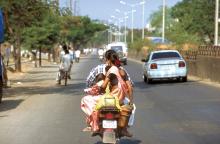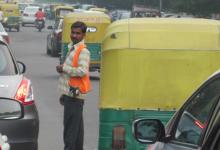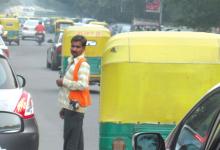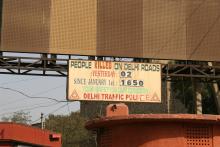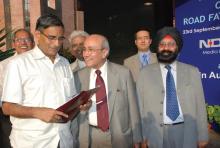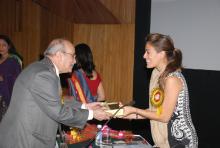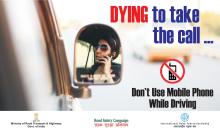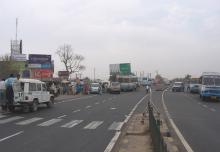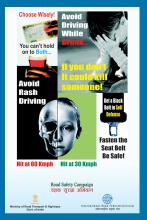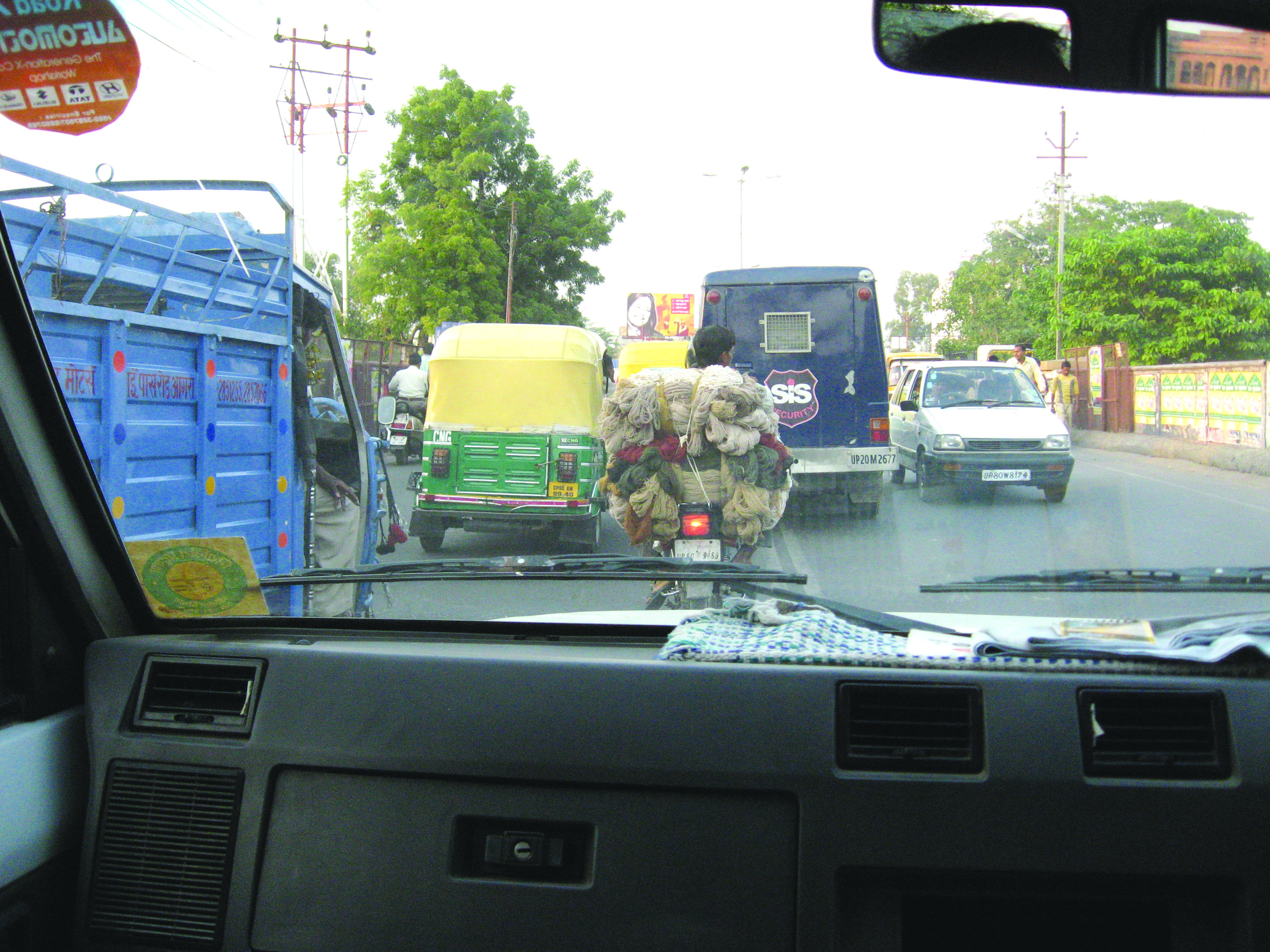
India's growth rate is the envy of the world, and its infrastructure is rapidly improving, but its road safety record is the world's worst. Patrick Smith reports on a conference aimed at finding answers to the problems
Ambling through the gardens and marble magnificence that is the Taj Mahal or gazing down on the city of Jaipur from the hilltop Jaigarh Fort is far removed from the world outside.
This is India, the country with arguably the world's highest economic growth rate; recently unveiled plans for the world's cheapest car (see separate story); the world's biggest roadbuilding programme, and tragically the highest road fatality rate in the world.
The 460-year-old Taj Mahal palace in Agra is one of the wonders of the world. Jaipur, the Pink City and capital of the state of Rajasthan, boasts dozens of historical sites such as the City Palace, home to the world's two largest silver objects, giant vases used by Raja Sawaii Man Singh II to carry water from the holy Ganges when he visited England, and Jaigarh Fort, which houses the world's largest canon on wheels.
For a few hours the visitor is removed from the congested reality of these bustling cities, each about 240km from the Indian capital, New Delhi, with which they make up a popular tourist route known as the Golden Triangle.
But this golden wonder is not to be confused with the Golden Quadrilateral, part of the National Highways Development Project (NHDP), an ambitious and fast-moving, six-phase development programme to give the country world-class roads.
The 6,000km Golden Quadrilateral route, upgraded in many parts to four or six lanes, links the four metro cities of Delhi, Mumbai, Chennai and Kolkata. Its 7,000km long North-South, East-West corridors will connect Srinagar-Kanyakumari and Silchar-Porbandar respectively.
Today history is very much repeating itself. The incredible, still visible, building feats of centuries ago are being complemented by the most ambitious set of construction programmes in India's history, and millions of people are being lifted out of the low income group to form a new middle class.
Like its neighbour China, where modern imported foreign cars can be seen everywhere in major cities, economic growth has brought demands for more energy and a vast improvement in the country's transport links: road, rail, air and sea. The calls (perhaps not as fast as many would like) are being answered as are those for cheaper and safer methods of transport. Among others this has seen the Tata Group keeping the promise it made some years ago by building the world's cheapest car, the Nano, costing 1 Lakh (Rupees 100,000/US$2,500).
With only ten cars for every 1,000 people in India, the Nano will boost car ownership (estimates of 1.8-2 million have been made), and importantly it is claimed it will be safer than a motorcycle.
Riders, along with pedestrians, account for the biggest number of deaths on Indian roads.
India's population is more than 1 billion, and it has a road network of more than 3.3 million km, making it one of the largest in the world, but in many cases the quality of the roads is inadequate and cannot meet the needs of efficient and fast moving transportation. Its national highways, the prime arterial routes, cover nearly 67,000km (2% of the network) and cater for about 45% of the total road transport demand. In general roads carry 85% of passenger and 70% of freight traffic.
The total vehicle population is more than 70 million (and increasing fast) and comprising around 73% two-wheelers; 13% cars/SUV-type vehicles; 5% goods vehicles; 2% buses and other vehicles.
According to A P Bahadur, chief engineer, Department of Road Transportation and Highways: "During the last 50 years India's vehicle population increased by 109 times; passenger and goods vehicles transport increased by 125 times but the total road length increased only by nine times. This mismatch and other factors have been a major contributory factor for poor safety on roads in India.
"Comparison with other developed countries reveals that although the number of accidents in India in absolute terms many not be high, the fatality rates related to the number of vehicles is the highest. India accounts for just 1% of the world's vehicular population but has 10% of all fatalities occurring on roads. Metropolitan cities account for 10% of road fatalities in India."
It has been estimated that highways contribute a major share of deaths (1%) in India, and the number of deaths due to accidents are 7.6% of the total accident fatalities in the road sector worldwide and 21.5% of the total road deaths in Asia.
A few years ago the
Indeed, the tolled Jaipur-Kishangarh Expressway (GVK Expressway), part of the Delhi-Mumbai corridor of the Golden Quadrilateral on National Highway 8, is proving a success, according to Ashwani Sharman, the road's deputy general manager-maintenance.
It is one of India's largest build-operate-transfer (BOT) highway projects to date, and when opened a few years ago was India's first six-lane public-private participation expressway (
This is a restricted highway, but many are not, and vehicles vie for space with almost all known forms of surface transport from new cars to trucks, to two and three-wheeled vehicles and from elephants and camels to overladen carts. Into this mix walks the pedestrian.
According to Sheila Dikshit, Chief Minister of Delhi, at any one time there are 28 different types of vehicles on the city's roads, although efforts are being made to improve traffic for the 2010
While India's economic growth has proved a magnet for foreign companies, including construction equipment manufacturers, who have opened representative offices or manufacturing facilities in the country, behind this explosive rise in wealth is the fact that accidents on Indian roads are on the increase.
Road accidents are today a major killer both nationally and globally, causing immense economic loss and social deprivation to the families of those involved in such accidents.
Road safety has thus emerged as a global concern and in this context, the deliberations at the recent
A variety of views and proposed solutions were put forward at the two-day conference held in the Indian capital New Delhi about what was, could and should be done to tackle the situation. There was agreement on a wide-ranging set of draft recommendations, which if implemented could see a reduction in road accidents and related deaths and injuries (see separate story).
Conference chairman Kiran Kumar Kapila (K. K. Kapila), is also the IRF's vice chairman and chairman and managing director of Intercontinental Consultants and Technocrats (ICT). The ISO 9001 certified, multi-disciplinary company of international consultants provides consultancy services for all facets of planning, preliminary and detailed engineering design and construction supervision of infrastructure projects, including many of India's new roads.
He said: "The scenario emerging in India is that though better quality roads are being built, the road accident rate has gone up appreciably. There is a wide array of vehicles available, and consequently the number of vehicles and their speed has increased. Road accidents are a global phenomenon, but the percentage of road fatalities in our country is abnormally high. Therefore, there is an immediate need to address all aspects of road safety, and come up with solutions which will help contain this menace."
Sundar on safety
One of the main recommendations from the conference (see separate story), put forward with "overwhelming consensus," was for the introduction of recommendations of the Sundar Committee, particularly for the setting up of the National Road Safety Board.
During its deliberations, the committee carried out an international review of road safety practices in the United States, Australia, Sweden and the UK.
What emerged from a review of international best practices was that most countries had stated policies to reduce road accidents, injuries and fatalities, and had set themselves targets. India had not yet formulated a National Road Safety Policy, although a draft under-consideration policy from the Ministry was referred to the committee for its consideration: it suggested certain amendments to the National Road Safety Policy for adoption by the Indian Government.
Wide-ranging recommendations were made in a report of the committee on Road Safety and Traffic Management published last year.
The committee was chaired by Shri S. Sundar, former Secretary to the Government of India's Ministry of Surface Transport (now the National Highways Authority), and a Distinguished Fellow, of TERI (Tata Energy Research Institute). He told the conference that on average each year road traffic accidents (RTIs) in India resulted in more than 100,000 deaths; 2 million hospitalisations and 7.7 million minor injuries. Apart from the human misery, the economic cost is estimated at Rupees 55,000 crores (Rupees 550 billion/US$14 billion) or about 3% of gross domestic product.
"There are many disease control programmes in India. This is necessary, but it is also necessary that road accidents are as much a public health issue and we do not have a structured programme with adequate outlay of funds to promote road safety and reduce mortality," said Sundar.
He said that approximately 30% of all road traffic victims are pedestrians followed by cyclists and two-wheelers.
"In most countries there is a political commitment at the highest level to reduce the number of road accidents. The UK is aiming at a 40% reduction by 2008 from the 1996 figures and Sweden aims to reduce accidents to close to zero. Every country in the world is committed to bring about a reduction in deaths and accidents." He said in India there was a lack of commitment and policy, inadequate funding and weak regulatory framework. Like other delegates he called for political commitment at national and state level to reduce accidents and fatalities, the adoption of a national road safety policy along with a comprehensive national road safety and traffic management Act to address road safety issues in respect of National Highways, mechanically propelled vehicles, and set guidelines on road safety on other roads encompassing the provisions related to road safety contained in other relevant Acts.
The Act would also establish a National Road Safety and Traffic Management Board and enable the setting up of such boards in the states, and the establishment of a National Road Safety Fund with funds coming from the cess on diesel and petrol.
Late last year it was announced that the government will bring in legislation on the National Road Safety Policy, with the recommendations of the Sundar Committee on that proposed policy now under active consideration.
Key objectives of the proposed policy recommended by the Sundar Committee include establishing a road safety information database, ensuring safer road infrastructure by way of designing safer roads, strengthening the system of issuing driving licences, taking appropriate measures for enforcement of safety laws, ensuring emergency medical attention for road accident victims and creating a dedicated agency, the National Road Safety Board, to oversee issues relating to road safety.
In a presentation Professor P. K. Sikdar of ICT said a road accident is the result of a mismatch of the road, the vehicle, the road user and the road environment, and while it is often stated that 95% of all accidents are the road users' fault, this is probably not correct and is a borrowed statement from the west where it is likely to be correct.
He said that a lot is yet to be achieved in Indian road engineering and enforcement, and pointed to the causes of the poor road safety situation as being poorly designed/tested vehicles; poorly maintained vehicles; poor traffic discipline and education; poorly designed/ maintained roads; poor level of enforcements; poor/primitive traffic management, and mixed traffic with non-motorised traffic mingling with fast traffic.
Professor Sikdar said that road safety policy must have a road safety audit (RSA) policy inbuilt, with an RSA being defined as a formal examination of an existing or a new road or a traffic project in which an independent RSA team reports on the accident potential and safety performance.
Its specific aims are to minimise risk and severity of accidents; minimise/avoid accidents on the network; meet the needs of safe use by all users; reduce long term cost of road scheme and improve awareness of safe design practices.
Modal share
Professor Dinesh Mohan, coordinator of the Transportation Research and Injury Prevention Programme, Indian Institute of Technology, Delhi, who was also on the committee, said that in many instances highways were being constructed without consideration for the modal share.
"We have to give some space for pedestrians and cyclists. Most countries have done something. What have we done? Nothing. On main highways there is no place for pedestrians or cyclists to move.
"In Mumbai 44% of people walk to work and 6% of people drive to work, yet 95% of the space is given to the car. In Delhi, 45% walk and bicycle to work. In some villages life has been made miserable by road design." He said that in future much more consideration should be given to road design to cater for pedestrians and cyclists. Highways must have continuous service roads; four lanes with service are better than six lanes roads; there should be no raised medians and there should be non-motorised crossings every kilometre or so.
He also questioned some of the suggested solutions regarding road safety, claiming that in certain cases they did not have a scientific basis.
"For example, it is safer to go on an Indian highway on an overloaded bus than in your own car. Unsafe vehicles like three-wheel tuk-tuk are probably the most efficient taxi invented for urban areas. It can't exceed the speed limit, takes less space than cars, yet we want to ban it." He said that many lives could be saved by looking at vehicle crashworthiness, seat belts, airbags, child seats, red light cameras, speed control, traffic calming and traffic separation.
Deaths would be reduced by 30-35% if the national law on crash helmets was implemented in every state; by 10-13% by using headlights in daylight and by 20-25% by breath testing suspected drink-drivers because "alcohol is a problem." "We must also reintroduce all types of roundabouts for state and national highways. Thousands of traffic lights have been removed in Europe and elsewhere.
"Roundabouts reduce skids and decrease deaths by 50%," said Professor Mohan, who also suggested that pedestrian crossings must be raised well above road level.
A drive towards safety
A total of 26 presentations were made by delegates at the conference, and in the final panel discussion, draft recommendations were drawn up.
There was overwhelming consensus regarding the recommendations of the Sundar Committee, particularly for the setting up of the National Road Safety Board, which would then set out the policy objectives, supported with Plan Funds requirements for meeting the cost of approved safety programmes. A National Coordination Body and similar state level organisations also need to be put in place to provide the most effective safety monitoring mechanism for the road system in India.
The nodal Ministry of Shipping, Road Transport and Highways may consider according high priority for accepting this proposal and advise the state governments to set up similar state level organisations.
Other recommendations
-
The design of appurtenant roadside developments should be served only through service roads with properly designed access/ exits with acceleration and deceleration lanes from the main highway.
-
Road safety audits need be made mandatory for each phase of road development, and should be implemented uniformly on all National Highway (NH) and State Highway (SH) projects.
-
Only accredited road safety auditors should be allowed to carry out safety audits.
-
All safety provisions for a project should be detailed and made bill of quantity items, and not left to the discretion of the contractor.
-
Ensure uniformity in respect of signages, signals, and road markings to help and guide road users. Strict compliance to prescribed and accepted standards is mandatory.
-
Awareness drive and education of the public living along the roads, is necessary to sensitise them about the various safety requirements. The education in schools through proper curricula is recommended.
-
Issue smart cards for driving licences and registration certificates for vehicles, with electronic linking of regional transport offices of states.
-
State governments to enforce traffic laws, take effective measures to control overloading, and take steps for installation of unified check post at state borders.
-
Develop an efficient system of traffic management involving coordination between different agencies, authorities, and defining their respective role.
-
Scientifically investigate accidents, particularly serious and fatal accidents, to find out the real cause in order to take corrective measures.
-
Introduce highway patrols to enforce traffic rules and regulations, and identify unauthorised encroachments.
-
In urban areas with heavy pedestrian movements, free left turns on crossing should be banned and pedestrians should be given the right to cross.
-
Motorcycles should switch on their lights at all times, and the wearing of crash helmets should also be strictly enforced with immediate effect.
-
Strict enforcement to check drunken-driving should be put in place using teams with the necessary testing apparatus.
-
Standards for expressways should be formulated at the earliest date, and the existing safety IRC standards reviewed immediately.
-
Weigh in motion equipment to be installed to check overloading and to comply with the directions of the Supreme Court.
-
In urban areas in particular, lane driving should be made compulsory. Attempts should also be made to segregate different types of vehicles such as carts, cycle, pedestrians, two wheelers, buses, and cars.
-
On highway projects public consultation should be considered at pre-feasibility stage.
-
A high priority and the necessary budget should be given for black spot identification along with measures to rectifiy them.
-
Appropriate legislation should be framed to empower highway patrols to enforce traffic rules and book violators to support road safety programmes.
-
All buses in metropolitan areas should drive in their lane, with overtaking of buses strictly banned.
-
Install cameras on busy road junctions to catch traffic violators.

